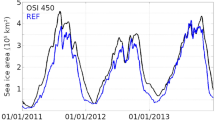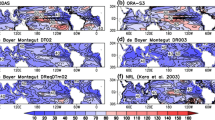Abstract
The heat budget is analyzed in the surface–layer (0–50 m) Pacific of the equatorial band (10°S–10°N), using the simulation of an ocean general circulation model from 1945 to 1993. The analysis indicates that downward net surface heat flux from the atmosphere and ocean advective heat fluxes play distinct roles in seasonal and interannual variabilities of surface–layer ocean temperature. The surface heat flux dominantly determines the ocean temperature in the seasonal time–scale. But, it has a negative feedback to the ocean temperature in the interannual time–scale. The interannual variability of ocean temperature is largely associated with the cold advection from off-equatorial divergent flow in the central Pacific and from upwelling in the cold tongue. Both the surface heat flux and ocean advective heat fluxes are important to the ocean temperature during an El Niño event. The ocean advective heat fluxes are further associated with local westward trade wind in the central Pacific. These results are largely consistent with some regional observational analyses.
Similar content being viewed by others
References
Battisti, D. S., and A. C. Hirst, 1989: Interannual variability in a tropical atmosphere-ocean model: Influence of the basic state, ocean geometry, and non-linearity. J. Atmos. Sci., 46, 1687–1712.
Chen, D., A. J. Busalacchi, and L. M. Rothstein, 1994: The role of vertical mixing, solar radiation, and wind stress in a model simulation of the sea surface temperature seasonal cycle in the tropical Pacific Ocean. J. Geophys. Res., 99, 20345–20359.
da Silva, A. M., C. C. Young, and S. Levitus, 1994: Atlas of Surface Marine Data 1994. NOAA Atlas NESDIS 6-8, U.S. Department of Commerce, NOAA, NESDIS, 912pp.
Enfield, D. B., 1986: Zonal and seasonal variations of the near-surface heat balance of the equatorial Pacific Ocean. J. Phys. Oceanogr., 16, 1038–1054.
Fasullo, J., and P. J. Webster, 1999: Warm pool SST variability in relation to the surface energy balance. J. Climate, 12, 1292–1305.
Frankignoul, C, F. Bonjean, and G. Reverdin, 1996: Interannual variability of surface currents in the tropical Pacific during 1987–1993. J. Geophys. Res., 101, 3629–3647.
Firing, E., S. E. Wijffels, and P. Hacker, 1998: Equatorial subthermocline currents across the Pacific.J. Geophys., Res., 103, 21,413–21,423.
Gill, A. E., 1982: Atmosphere-Ocean Dynamics, Academic Press, Harcourt Brace Javanovich Publishers, 662pp.
Harrison, D. E., and N. K. Larkin, 1998: El Niño-southern oscillation sea surface temperature and wind anomalies, 1946–1993. Rev. Geophysics, 36, 353–399.
Hayes, S. P., P. Chang, and M. J. McPhaden, 1991: Variability of the sea surface temperature in the eastern equatorial Pacific during 1986–88. J. Geophys. Res., 96, 10,553–10,566.
Horel, J. D., 1982: On the annual cycle of the tropical Pacific atmosphere and ocean. Mon. Wea. Rev., 110, 1863–1878.
Huang, B., and Z. Liu, 2001a: Temperature trend of the last 40 years in the upper Pacific Ocean. J. Climate, 15, 3738–3750.
Huang, B., and Z. Liu, 20001b: Temperature trends in the upper tropical Indian Ocean: 1955–1993. Dynamics of Atmospheric and Oceanic Circulations and Climate, Edited by Institute of Atmospheric Physics, Chinese Academy of Sciences, Beijing, China, 413-433.
Lau, K. M., and C. H. Sui, 1997:Mechanisms of short-term sea surface temperature regulation: Observations during TOGA COARE. J. Climate, 10, 465–472.
Levitus, S., 1982: Climatological Atlas of the World Ocean. NOAA Professional Paper 13, U.S. Department of Commerce, 173 pp.
Liu, T. W., and C. Gautier, 1990: Thermal forcing on the tropical Pacific from satellite data. J. Geophys. Res., 95, 13,209–13,217.
Liu, Z., and B. Huang, 2000: Cause of the tropical Pacific warming. Geophys. Res. Lett. 27, 1935–1938.
McPhaden, M. J., and J. Picaut, 1990: El Niño-southern oscillation displacements of the western equatorial Pacific warm pool. Science, 250, 1385–1388.
Pacanowski, R. C, 1996: MOM2 Documentation. GFDL Ocean Technical Report 3.2, 329pp.
Philander, S. G. H., W. J. Hurlin, and A. D. Seiged, 1987: Simulation of the seasonal cycle of the tropical Pacific Ocean. J. Phys. Oceanogr., 17, 1986–2002.
Picaut, J., and T. Delcroix, 1995: Equatorial wave sequence associated with warm pool displacements during 1986–1989 El Niño-La Nina. J. Geophys. Res. 100, 18,393–18,408.
Rasmusson, E. M., and T. H. Carpenter, 1982: Variations in the tropical sea surface temperature and surface wind fields associated with the Southern Oscillation /El Niño. Mon. Wea. Rev., 110, 354–384.
Reed, R.K., 1986: Effects of surface heat flux during the 1972 and 1982 El Niño episodes. Nature, 322, 449–450.
Reynolds, R. W., and T. M. Smith, 1994: Improved global sea surface temperature analysis using optimum interpolation. J. Climate, 7, 929–948.
Semtner, A. J., and R. M. Chervin, 1992: Ocean general circulation from a global eddy-resolving model. J. Geophys. Res., 97, 5493–5550.
Swenson, M. S., and D. V. Hansen, 1999: Tropical Pacific Ocean mixed layer heat budget: The Pacific cold tongue. J. Phys. Oceanogr., 29, 69–81.
Wang, C, 2000: The 1997–98 El Niño evolution relative to previous El Niño events. J. Climate., 13, 488–501.
Wang, W., and M. J. McPhaden, 1999: The surface-layer heat balance in the equatorial Pacific Ocean, Part I: Mean seasonal cycle. J. Phys. Oceanogr., 29, 1812–1831.
Wang, W., and M. J. McPhaden, 2000: The surface-layer heat balance in the equatorial Pacific Ocean, Part II: Interannual variability. J. Phys. Oceanogr., 30, 2989–3008.
Weare, B. C, 1983: Interannual variation in net heating at the surface of the tropical Pacific Ocean. J. Phys. Oceanogr., 13, 873–885.
Weisberg, R. H., and C. Wang, 1997: Slow variability in the equatorial west-central Pacific in relation to ENSO. J. Climate., 10, 1998–2017.
Wyrtki, K., 1975: El Niño—the dynamic response of the equatorial Pacific Ocean to atmospheric forcing. J. Phys. Oceanogr., 5, 572–584.
Wyrtki, K., and B. Kilonsky, 1984: Mean water and current structure during the Hawaii-Tahiti shuttle experiment. J. Phys. Oceanogr., 14, 242–254.
Author information
Authors and Affiliations
Corresponding author
Rights and permissions
About this article
Cite this article
Huang, B., Liu, Z. An OGCM simulation of seasonal and interannual variabilities in the surface–layer pacific of the equatorial band. Adv. Atmos. Sci. 19, 219–235 (2002). https://doi.org/10.1007/s00376-002-0018-8
Received:
Revised:
Issue Date:
DOI: https://doi.org/10.1007/s00376-002-0018-8




